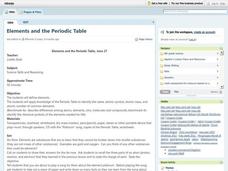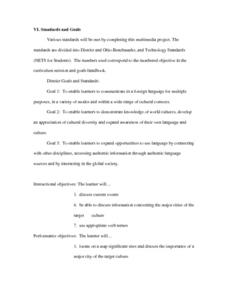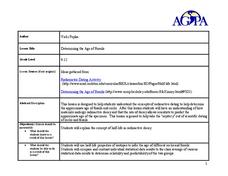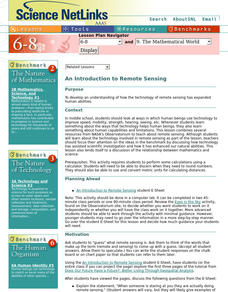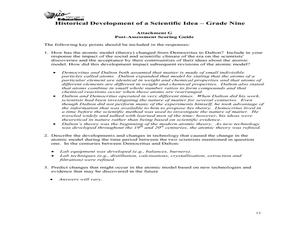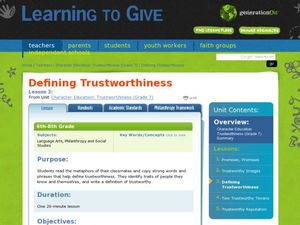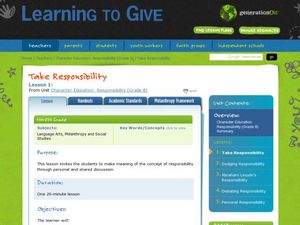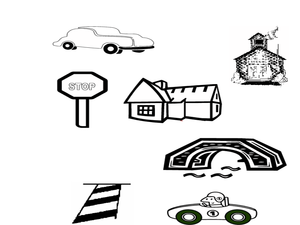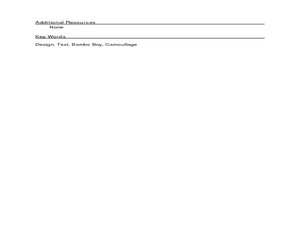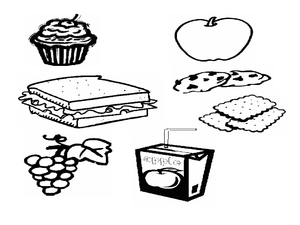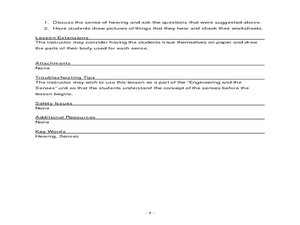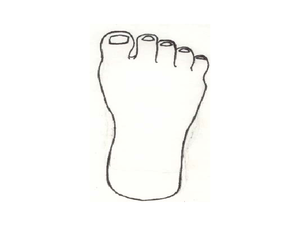Curated OER
Changes in Nature
Fifth graders explore changes in nature. They identify chemical and physical changes in the water cycle, carbon cycle, and weathering. Students explore a chemical or physical change based on a chemical formula. They examine the effects...
Curated OER
Elements and the Periodic Table
Students are introduced to the elements on the Periodic Table and what is meant by element. Using the Table, they identify the name, atomic mass, number and symbol of each element. To end the instructional activity, they discover the...
Curated OER
Geografia de Espana
Students play a board game called "Geografia de Espana. The object of the game is to reach the desired destination or region according to the color chosen by each play or group. Each player takes a turn to spin the spinner to find out...
Curated OER
Determining the Age of Fossils
Students examine the concept of radioactive dating. In this radioactive dating lesson, students investigate how to determine the ages of fossils and rocks as they learn about half-life radioactive decay.
Curated OER
Introduction to Philanthropy- Recognizing Good Citizenship and Philanthropy in Our Community
Students define philanthropy. In this community lesson, students read A River Ran Wild and discuss the needs in the communities presented. Students discuss aspects of philanthropy in a community and brainstorm elements of a healthy...
Curated OER
Sampling Rocks
Students study rocks they find on the playground. In this investigative lesson students collect and analyze rocks they find and answer questions about them.
Curated OER
Historical Development of a Scientific Idea
Ninth graders examine how scientist's contribute to atomic theory. In this development of a scientific idea lesson students work in groups and research the development of the atomic model.
Curated OER
Using Logos and Mission Statements to Communicate Sustainable Forestry Information
Young scholars survey forestry foundations to see how they represent important information into their logos and mission statements. In this forestry lesson plan, students use the information to better understand visual representations...
Curated OER
Mathematicians Research Projects
Young scholars research a famous mathematician and create a presentation of their research. In this famous mathematician research lesson, students decide on a famous mathematician that they would like to learn more about. They conduct...
Curated OER
Wall of Philanthropists: King Day (7th)
Students recognize the importance of justice, tolerance, equality, and historical figures. In this philanthropic actions activity, students study the philanthropic actions of historical figures, and learn about the concepts of fairness,...
Curated OER
What is Honesty?
Young scholars explore the concept of honesty. In this character lesson, students work in groups to brainstorm and discuss what it means to be honest. Each group shares their ideas with the class and they keep a list of keywords and...
Curated OER
Defining Trustworthiness
Students explore the trait of trustworthiness. In this character education lesson, students discuss the attributes of people they trust. Students create a group definition of trustworthiness.
Curated OER
Fairness Metaphor
Students write a metaphor. In this descriptive writing lesson, students define metaphor. Students come up with a creative metaphor to describe their feelings about fair practices related to music downloads.
Curated OER
Take Responsibility
Young scholars examine the importance of responsibility. In this character education lesson plan, students participate in a group discussion to explore and define responsibility.
Curated OER
Introduction to Materials: Properties of Materials
Students explore the properties of matter. In this properties of materials lesson, students examine wood, metal, rubber, Styrofoam, and plastic. Students identify the attributes of each of the materials.
Curated OER
Designing a Safe City Like a Civil Engineer
Students study civil engineering, safety apparatuses in their city, and design their own city. In this civil engineering lesson, students discuss their towns safety apparatuses and define civil engineers. Students then design their own...
Curated OER
The Saturday Morning Superhero:
Students explore the concept of engineering design. In this engineering design process lesson, students read The Saturday Morning Superhero and discuss the problem solving steps that the main character encounters as he creates...
Curated OER
Engineering and the Senses
Students explore nutrition. In this nutrition lesson, students discuss a person's sense of taste and how it is different for each person. Students discuss favorite foods and how they relate to nutrition. Students cut out pictures of...
Curated OER
Engineering and the Senses: Hearing
Students explore the sense of hearing. For this 5 senses lesson, students consider how humans and animals use the sense of hearing along with their other senses. Students discuss the body parts responsible for the 5 senses and...
Curated OER
Biomedical Engineering: Wacky Shoes
Students create 'wacky' shoes as a part of a biomedical engineering activity. In this bioengineering lesson, students investigate old shoes cut in half and discuss the purpose of each shoe layer. Students use a shoe template to design...
Curated OER
Products of an Electrical Engineer
Students explore products made by an electrical engineer. For this engineering lesson, students complete two worksheets identifying products made by an electrical engineer.
Curated OER
Principles of Integrity
Eighth graders analyze phrases that represent having integrity. In this integrity lesson plan, 8th graders discuss what it means to be true to yourself and be honest when no one is looking.
Curated OER
Models for Dividing Fractions
Sixth graders represent division of fractions using manipulatives, such as freezer pops, candy bars, and models such as drawings squares. They develop an algorithm from these examples and solve problems using fractions.
Curated OER
Millions, Billions, Trillions
Students use real-world data to compare the relative sizes of millions and billions, and exponential growth. They use the salaries of famous people such as, Michael Jordan and Bill Gates to understand this math concept.

